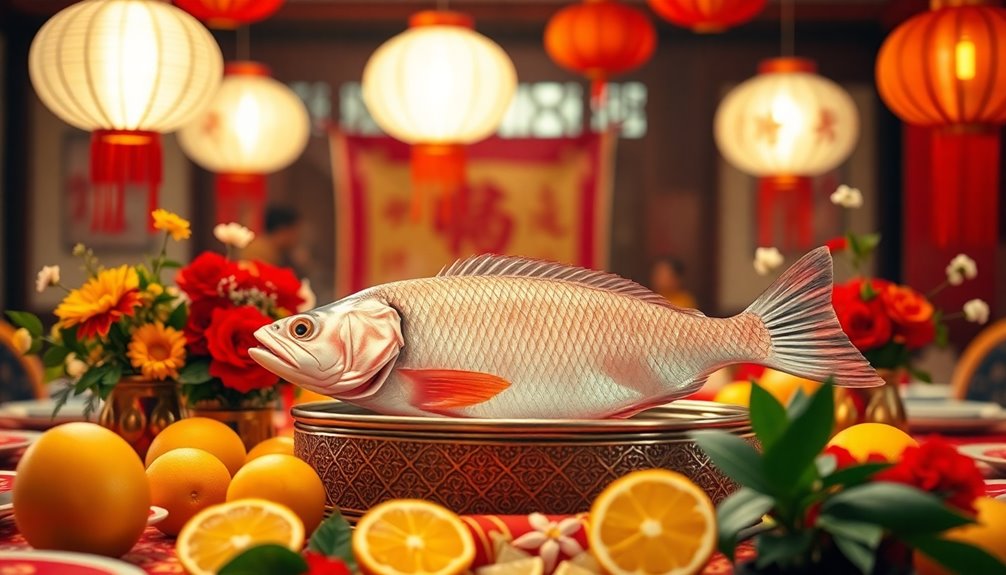During Chinese New Year, the fish symbolizes abundance and prosperity. You’ll often hear the phrase “nian nian you yu,” which translates to having plenty each year. Serving a whole fish, usually on New Year’s Eve, represents completeness and respect for family. The head is positioned towards elders as a sign of honor, and leaving leftovers signifies hope for continual prosperity. This tradition isn’t just about food; it brings families together and reinforces cultural connections. If you’re curious about the culinary customs and variations surrounding this tradition, there’s more to explore! In addition to the significance of fish, other customs such as the lighting of Chinese sky lantern traditions add to the festive atmosphere of the New Year. These lanterns symbolize the release of one’s hopes and dreams for the coming year, illuminating the night sky with vibrant colors. As families gather to celebrate, they share stories and wishes while enjoying various traditional dishes, creating a sense of unity and belonging that transcends generations.
Key Takeaways
- Fish symbolizes surplus and abundance during Chinese New Year, representing the hope for wealth year after year through "nian nian you yu."
- Serving whole fish on New Year's Eve signifies family respect, completeness, and prosperity for the coming year.
- The head of the fish facing elders demonstrates honor and respect within family hierarchies.
- Leftover fish is reserved for the next day, symbolizing ongoing abundance and continued prosperity.
- Various seafood dishes reflect regional customs, with each type carrying its own symbolic meanings related to good fortune.
Significance of Fish in Tradition
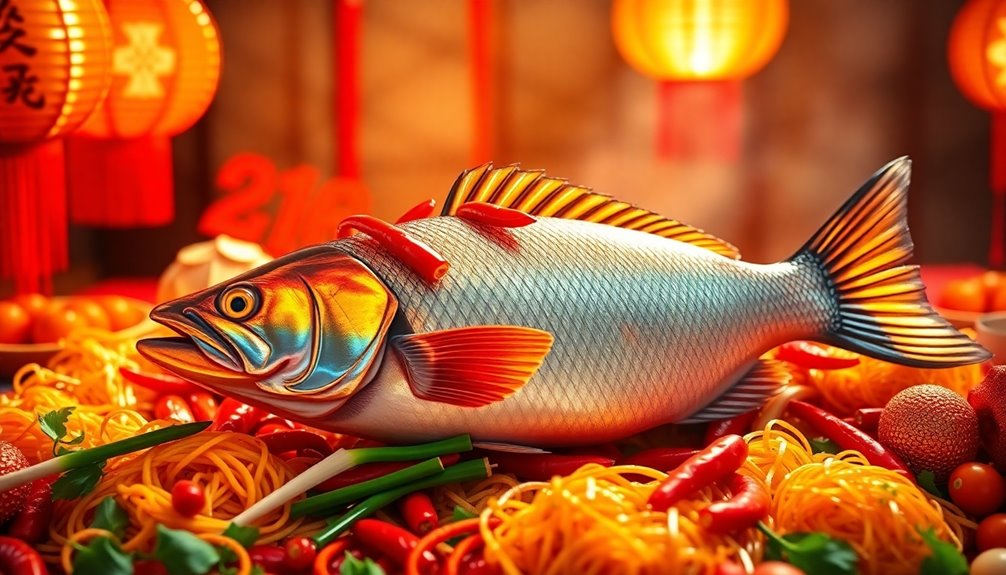
Fish plays an essential role in Chinese New Year traditions, symbolizing surplus and abundance. During the Lunar New Year celebrations, the phrase "nian nian you yu" expresses hopes for wealth year after year.
The significance of fish extends beyond its delicious taste; it represents prosperity and a bountiful future. On New Year's Eve, serving whole fish with the head and tail intact symbolizes completeness and respect for family hierarchy.
You'll notice that the fish is often presented with its head facing elders or honored guests, highlighting the importance of family. By eating only the middle portion at first and leaving the head and tail for the next day, you embrace the hope for ongoing abundance throughout the year.
Symbolism of Whole Fish
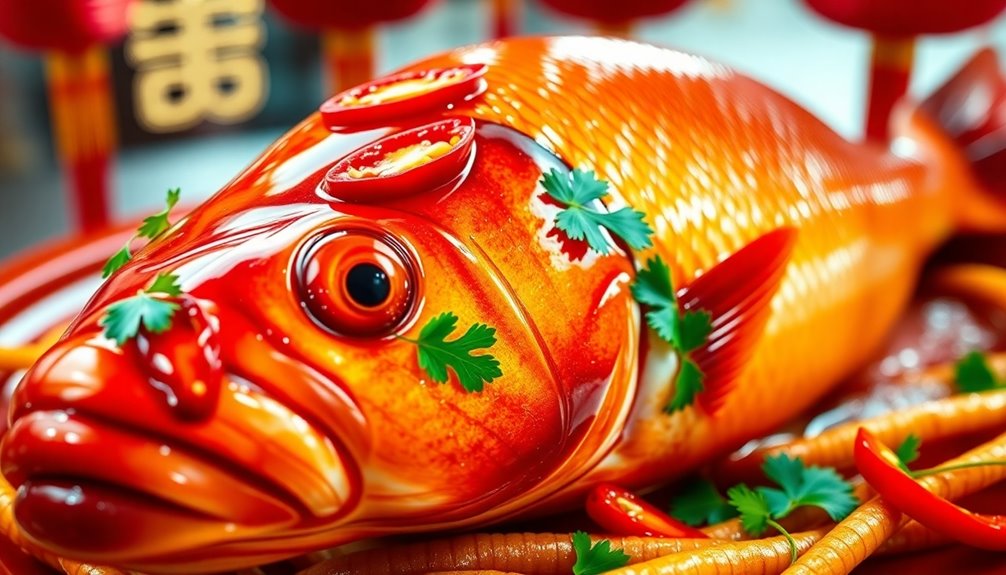
Serving a whole fish during Chinese New Year celebrations carries deep symbolism tied to abundance and prosperity. The whole fish (鱼) is a powerful symbol, as its name sounds like the word for "plenty" (充).
This tradition emphasizes completeness, marking a good beginning and ending for the year. The head and tail represent wholeness, and it's customary to leave them uneaten until the next day, hoping for continued abundance and prosperity throughout the year.
Typically, a steamed fish garnished with scallions and ginger is served, with the head facing elders or honored guests as a sign of respect. Consuming fish on New Year's Eve and New Year's Day reinforces the wish for surplus wealth and fortune, known as Niannian Youyo.
Culinary Customs Surrounding Fish
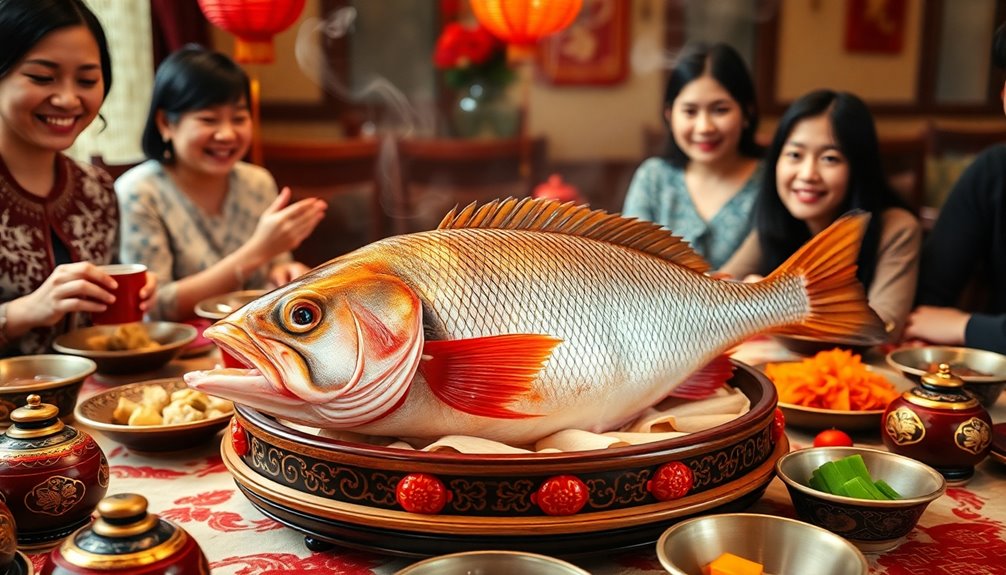
Culinary traditions during Chinese New Year often highlight fish as a centerpiece, showcasing its significance in symbolizing abundance. Serving a whole fish on New Year's Eve and New Year's Day embodies wishes for prosperity and wealth, aligning with the phrase "nian nian you yu."
Here are some key culinary customs surrounding fish:
- The head and tail of the fish represent a good beginning and ending to the year.
- Leftover fish from the New Year's Eve dinner signifies continued prosperity, with parts reserved for the next day.
- Common preparations include steaming, glazing, or frying, often enhanced with scallions and ginger.
Variations of Fish Dishes
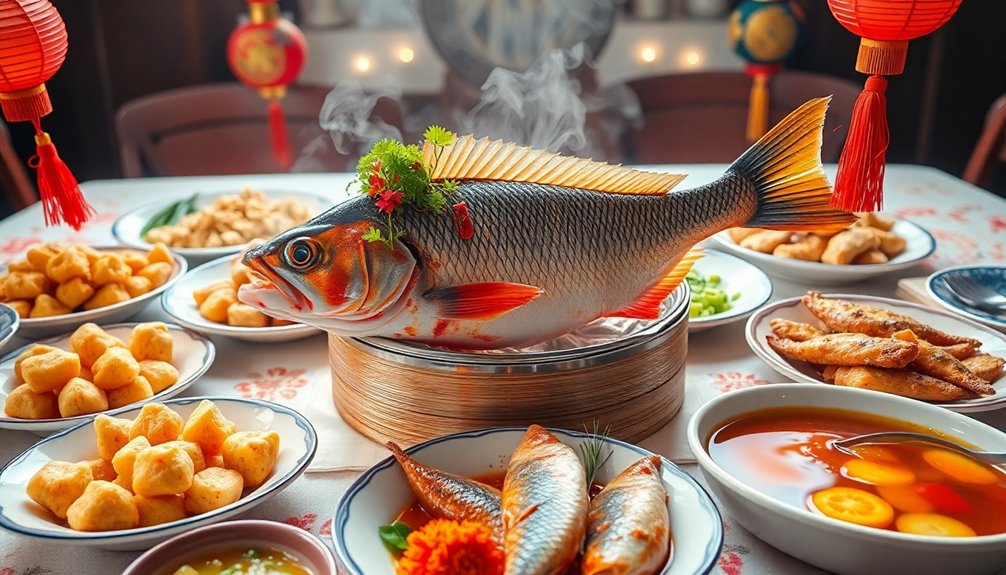
When it comes to variations of fish dishes for Chinese New Year, you'll find a rich tapestry of cooking methods and regional preferences.
From steamed prosperity fish to glazed delights, each style brings unique flavors to the celebration.
Plus, the way these fish are presented often reflects deep respect for tradition and the guests at the table.
Cooking Methods Overview
Fish dishes during Chinese New Year showcase a variety of cooking methods that highlight their flavors and cultural significance. Each method not only enhances the taste but also aligns with traditional symbolism.
Here are some popular techniques:
- Steaming: This method enhances the natural flavors and is often paired with aromatics like scallions and ginger.
- Baking or Glazing: These methods add a rich flavor profile while maintaining the whole fish presentation.
- Frying: Although less common for ceremonial dishes, frying gives the fish a crispy texture.
In southern China, you'll see vibrant garnishes and sauces, while northern styles favor simpler seasoning.
Presentation is key, with whole fish displayed prominently, emphasizing its important symbolic meaning during the festivities.
Regional Fish Variations
Regional variations in fish dishes during Chinese New Year reflect the rich cultural tapestry of China and its diverse culinary practices.
In northern China, you'll find jiaozi taking center stage, but serving whole fish remains common, symbolizing abundance and wealth.
Meanwhile, in the southern regions, particularly Guangdong, colorful seafood dishes like steamed garoupa or pomfret celebrate local flavors.
The Yangtze River area often features the Chinese mud carp, known as the traditional Prosperity Fish, typically steamed with ginger and scallions.
Coastal areas indulge in more exotic seafood, such as lobster or crab, representing luxury and good fortune.
Many traditions include rituals like leaving the head and tail of the fish for the next day, signifying hope for ongoing prosperity throughout the year.
Presentation Styles and Techniques
In Chinese New Year celebrations, the presentation of fish dishes plays an essential role in conveying respect and cultural significance.
You'll often see a whole fish displayed on a large platter, with its head facing honored guests, symbolizing familial hierarchy.
Key presentation styles include:
- Steaming: Enhances natural flavors, often with scallions and ginger.
- Garnishes: Aromatics and broths like soy sauce or chili oil add depth.
- Cultural significance of leftovers: Leaving the head and tail symbolizes hope for continued wealth.
Variations like Steamed Prosperity Fish in the South reflect regional preferences and family traditions, showcasing the importance of symbolic dishes in fostering unity and abundance during the holiday.
Cultural Importance of Seafood
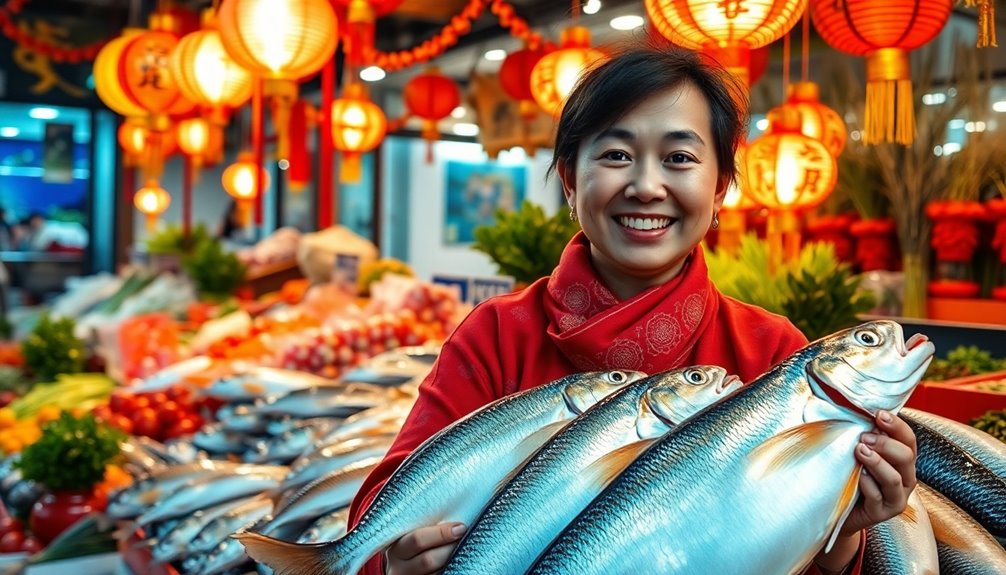
While celebrating Chinese New Year, you'll find that seafood plays an essential role in the festivities. Fish, in particular, symbolizes abundance and prosperity, as its name (鱼) sounds like the word for surplus (余) in Mandarin.
Traditionally, whole fish is served on New Year's Eve and Day to wish for wealth to flow into the new year, embodying good luck. Various types of seafood, like shrimp and dried oysters, bring their own symbolic meanings tied to joy and fortune.
This tradition emphasizes respect for elders and reinforces family unity, as shared meals are significant for collective hopes. The cultural importance of seafood during the Lunar New Year highlights the significance of maintaining heritage and celebrating abundance together.
Related Symbolic Foods

Seafood isn't the only food with symbolic significance during Chinese New Year. Many dishes represent prosperity, family unity, and good fortune.
Here are some key symbolic foods to enjoy:
- Dumplings: Their shape resembles ancient silver ingots, and eating more is believed to bring greater wealth.
- Longevity Noodles: These long, unbroken strands symbolize the wish for a long life and are often served in broth.
- Sweet Rice Balls (Tang Yuan): Their chewy texture represents family unity and togetherness, often enjoyed in a sweet broth.
Other favorites include Spring Rolls, signifying good fortune, and Year Cake (Nian Gao), which symbolizes progress.
Each dish enhances the festive spirit of the Lunar New Year and deepens your celebration with rich traditions.
Preparation and Serving Techniques
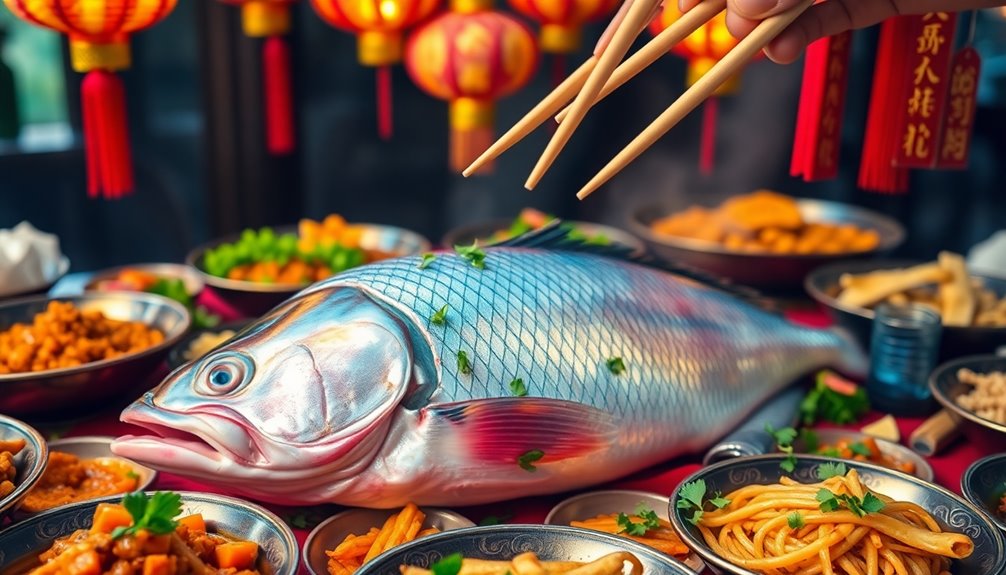
When preparing fish for Chinese New Year, you'll want to contemplate methods like steaming, baking, or frying, with steaming being the most popular choice for preserving flavor.
Presentation is just as important, so make sure to serve the whole fish on a large platter, garnished beautifully, and positioned to honor your guests.
Cooking Methods Overview
Three main cooking methods dominate the preparation of fish during Chinese New Year: steaming, baking, and frying.
Steaming is the most traditional method, enhancing the fish's natural flavor and ensuring a healthier dish. Aromatics like scallions and ginger elevate the taste and aroma during preparation.
- Whole fish symbolizes completeness and abundance.
- Leftovers represent the continuity of wealth throughout the year.
- The presentation of the fish head facing the elder signifies respect and good fortune.
Presentation and Serving Tips
Presenting a whole fish during Chinese New Year is a cherished tradition that embodies the values of completeness and abundance. To honor this practice, steam the fish to preserve its freshness, adding aromatics like scallions and ginger for flavor.
For presentation, place the whole fish on a large platter, ensuring the head faces the elder guests to show respect. Garnish it with fresh herbs and drizzle a light soy sauce or chili oil for visual appeal.
Frequently Asked Questions
What Is the Meaning of Fish in Chinese New Year?
In Chinese New Year, fish represents abundance and prosperity. When you eat fish during the celebrations, you're hoping for wealth and surplus in the year ahead.
The tradition of serving a whole fish at the New Year's Eve dinner highlights the importance of continuity in good fortune. By leaving the fish head and tail for the next day, you're expressing your desire for ongoing prosperity and blessings throughout the year.
What Is Symbolic About Chinese Fish?
Did you know that over 1.4 billion fish are consumed during Chinese New Year celebrations? In this situation, fish symbolizes abundance and prosperity.
You'll find that serving a whole fish represents completeness, with its head and tail signifying a good beginning and end. Eating fish while wishing "nian nian you yu" reflects hopes for wealth and surplus.
Plus, leftovers carry the promise of continued fortune throughout the year.
What Does Fish Represent for New Years?
When you think about fish for New Year's, it represents abundance and prosperity. The way you serve it, often whole, signifies completeness and a good start for the year ahead.
You might notice that families often eat just the middle part first, saving the head and tail for the next day, which symbolizes ongoing wealth.
Plus, placing the fish with the head facing honored guests shows respect and gratitude, reinforcing cultural values.
Why Do People Eat Half a Fish on Chinese New Year?
When you eat half a fish on Chinese New Year, it's all about abundance.
You'll notice the whole fish served, but only the middle portion gets eaten. By saving the head and tail, you're symbolically carrying over wealth and resources into the next year.
It's a meaningful gesture that reflects respect for family and tradition. Plus, leaving those parts behind reinforces the hope for continued prosperity in the days to come.
Conclusion
As you celebrate Chinese New Year, remember the fish's rich symbolism—prosperity and abundance—woven into every shared meal. Coincidentally, the whole fish you enjoy mirrors the hope for a complete and fulfilling year ahead. When you savor each bite, you're not just indulging in a culinary tradition; you're embracing a deeper connection to your heritage and the promise of new beginnings. So, as you gather with loved ones, let the fish remind you of the abundance that awaits.
